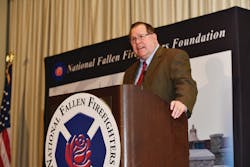Editor’s note: The Fire Politics column, “Tampa2: Updating the Path Forward,” in the May issue by Chief Dennis Compton, a Firehouse® contributing editor, reported on the March 2004 Firefighter Life Safety Summit and the recent 10th-anniversary Tampa2 Summit. Here are some additional observations by an attendee:
The agenda was clear at the Tampa2 summit: Figure out a more effective way to prevent firefighter line-of-duty deaths and bring the 16 Life Safety Initiatives to every firehouse across the nation. Delegates brainstormed relentlessly for two days in a progressive, productive and amicable environment. Imagine that. Labor and management, volunteer and career, big city and rural, all working together for a common goal in a 20-by-20-foot conference room. Proof that change in our culture is not only possible...it’s already happening.
Titles were left at the door. Rank held no merit. It was an all-inclusive environment where collaboration was paramount. Every voice was heard, every perspective considered. Kudos to the National Fallen Firefighters Foundation, the host and facilitator of the event, for doing it the right way.
All levels were represented, from blue-shirt volunteer firefighters to big-city career commissioners. Fire administrators, government officials, fire chiefs and senior officers, politicians, union leaders, executive directors, scholarship recipients and survivors of line-of-duty deaths from every corner of the country came together in what could be described as the greatest collection of mind-power in our industry.
The energy was palpable. Conference rooms and break sessions produced varying degrees of opinions and a litany of possible solutions. At the end of each day, the scope and depth of ideas brought out the best in everyone. Culture, tactics, technology, data, funding, fire prevention and education, corporate partnerships – no stone was left unturned. Every aspect of our profession was evaluated. Bold ideas were brought forth and new ways of thinking will help pave the way to preventing line-of-duty deaths.
As a survivor, I learned from people like Vina Brennan, the outspoken and courageous widow of an FDNY captain, that one voice can inspire an entire industry to start thinking differently about preventing line-of-duty deaths. Notice I didn’t say “reduce” them. That simply wasn’t good enough. As a blue-shirt firefighter at a small, suburban, one-station firehouse, I also learned that even someone at my level can make a difference.
Going forward, we need to take a hard look at ourselves no matter where we sit in our organizations. We need to ask the hard questions. Our profession is a dangerous one. We all know this. There are inherent risks involved in saving lives and protecting property. As firefighters and EMS providers, we accept those risks. What we cannot accept is another line-of-duty death. The 16 Life Safety Initiatives are put in place not only to remind us of the risks we face, but also to reduce and possibly eliminate them.
At the end of the conference, we all agreed on one thing. If you want to be a firefighter today, then you need to follow three simple rules:
1. Continue to educate yourself.
2. Stay mentally and physically fit.
3. Be a positive influence on the people around you.
It isn’t going to be easy, but we can help. And by we, I mean the National Fallen Firefighters Foundation, fire administrators, unions, fire officers, government officials, community leaders and all of us around the kitchen table in firehouses across the nation who advocate the 16 Life Safety Initiatives.
If you can’t follow these three simple rules, then you need not apply. It’s a harsh reality, I know, but nowhere near as harsh a reality as burying another firefighter.
Steve Tullis
PIO/Firefighter/Paramedic
Hinsdale Fire Department
Hinsdale, IL
The writer began his fire service career in 2001 as a paid-on-call firefighter with the LaGrange Park, IL, Fire Department, where he is currently a lieutenant. He is also a full-time firefighter, paramedic and public information officer with the Hinsdale Fire Department. He has a bachelor of arts degree from the University of Illinois at Chicago, is a member of the Illinois Life Safety Task Force and volunteers for the National Fallen Firefighters Foundation (NFFF) writing letters to survivors and attending the National Memorial Service. Previously, Tullis was a senior writer, brand steward and associate creative director for advertising agencies in Chicago, Seattle, London and Cape Town, South Africa. His father, Chief Arthur A. Tullis of the La Grange Park, IL, Volunteer Fire Department, died in the line of duty in 1999.
Keeping history alive
I really enjoyed David Liscio’s profile of retired Saugus, MA, Fire Chief Jim Blanchard, “Firefighting Lore Kept Alive,” in the April issue of Firehouse® and the chief’s interest in keeping fire lore alive.
I was a co-founder of the St. Francis Hook & Ladder Society back in 1972 to preserve the fire history of the San Francisco Fire Department.
What I found most interesting was Chief Blanchard’s correct reference to the rank insignia being a “trumpet,” not a “bugle.” It is amazing how many people use the expression, “bugle.” A bugle is a musical instrument that has three keys whereas a trumpet is actually a megaphone. It was used to amplify orders, hence the sound of authority. Great article.
Jack McCloskey
Captain (ret.)
San Francisco Fire Department
San Francisco, CA
Firehouse Readers
The readers of Firehouse® Magazine provide feedback, views, reactions and observations in the "Forum" section of the magazine.






